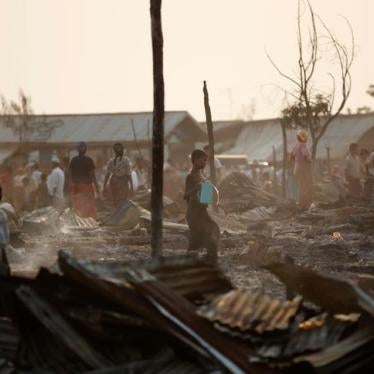(New York) – New satellite data is consistent with widespread burnings in at least 10 areas in northern parts of Burma’s Rakhine State, Human Rights Watch said today. The burnings follow a series of coordinated attacks by ethnic Rohingya militants on August 25, 2017 against dozens of Burmese government checkpoints and bases.
The Burmese government should grant access to independent monitors to determine the sources of fires and assess allegations of human rights violations.
“This new satellite data should cause concern and prompt action by donors and UN agencies to urge the Burmese government to reveal the extent of ongoing destruction in Rakhine State,” said Phil Robertson, deputy Asia director. “Shuffling all the blame on insurgents doesn’t spare the Burmese government from its international obligations to stop abuses and investigate alleged violations.”
On August 25, Arakan Rohingya Salvation Army (ASRA) militants attacked at least two dozen different police posts and checkpoints and one military base across three townships in northern Rakhine State. The government initially reported that dozens of people were killed in the fighting, including 11 members of the security forces. The reported death toll has since climbed to over 100, including many alleged Rohingya insurgents.
The attacks follow a buildup of military forces with the deployment of the 33rd Light Infantry Battalion in northern Rakhine State, which is predominately home to Rohingya Muslims. The media reports that the government has intensified security operations in the area. Both ARSA insurgents and the Burma Army accused the other side of committing abuses. Thousands have fled their homes amid ongoing fighting.
Satellites initially detected active fires in the early afternoon of August 25 in the village tracts of Zay Di Pyin and Koe Tan Kauk in Rathedaung township. On August 28, satellites located fires in another eight locations from mid-morning to early afternoon, including in Maungdaw town and several other villages in Maungdaw township. Human Rights Watch noted that many additional fires in northern Rakhine State might not have been detected during this assessment period because of limitations in the resolution of the environmental satellite sensors used and heavy clouds during the monsoon season.
Human Rights Watch compared the locations of these fires with witness statements it has collected and media reports, and found a correlation with some reported incidents where residences have allegedly been deliberately burned. For instance, one man who fled to Bangladesh from Taung Pyo Let Yar village, near where Human Rights Watch detected active fires, said he witnessed security forces shooting people as they chased militants, and that homes were set ablaze: “Everything has been burned to ashes by now,” he said.
Although it is not technically possible to determine the cause of fires detected with these satellite sensors nor exclude the possibility these are naturally occurring fires unrelated to the conflict, Human Rights Watch noted the information documented bears a close resemblance to that found during widespread arson attacks in Rakhine State during violence against the Rohingya in 2012 and 2016.
The overall area in which burnings were found is spread along an approximately 100-kilometer long stretch of Rakhine State, which is substantially larger than the approximately 20-kilometer long stretch in which burnings by Burmese security forces occurred from October to November 2016. Following the deadly attacks on police outposts by militants in October 2016, Human Rights Watch’s analysis of satellite imagery showed over 1500 buildings destroyed by arson.
The Burmese government and army blame Rohingya residents and militants for the burning of some structures, but thus far have not presented evidence to support their allegations. Widespread burning of this sort in Rakhine State has not been seen since Rohingya militants attacked government security forces on October 9, 2016. The Rohingya militant group Harakah al-Yaqin, which later changed its name to Arakan Rohingya Salvation Army, took responsibility for those attacks. At that time, the Burma Army launched so-called “clearance operations” in areas where it assumed militants were hiding, committing numerous and serious human rights violations against the Rohingya. Human Rights Watch documented extrajudicial killings and the rape of women and girls, in addition to the burning of structures.
The security force operations in October 2016 through March 2017 caused massive displacement, with more than 87,000 Rohingya fleeing to neighboring Bangladesh. A report issued by the UN Office of the High Commissioner for Human Rights on February 3 concluded that the attacks against the Rohingya “very likely” amounted to crimes against humanity.
In March, the UN Human Rights Council established an independent, international fact-finding mission with a mandate to investigate allegations of recent human rights abuses in Burma, especially in Rakhine State. The government has refused to cooperate with the mission and indicated it will deny visas to three experts appointed to the mission.
“The Burmese government has repeatedly shown that it has neither the interest nor the skill to credibly and impartially investigate abuses in Rakhine State,” said Robertson. “Concerned governments should press for independent investigations of serious rights violations, or there will be many more victims.”










